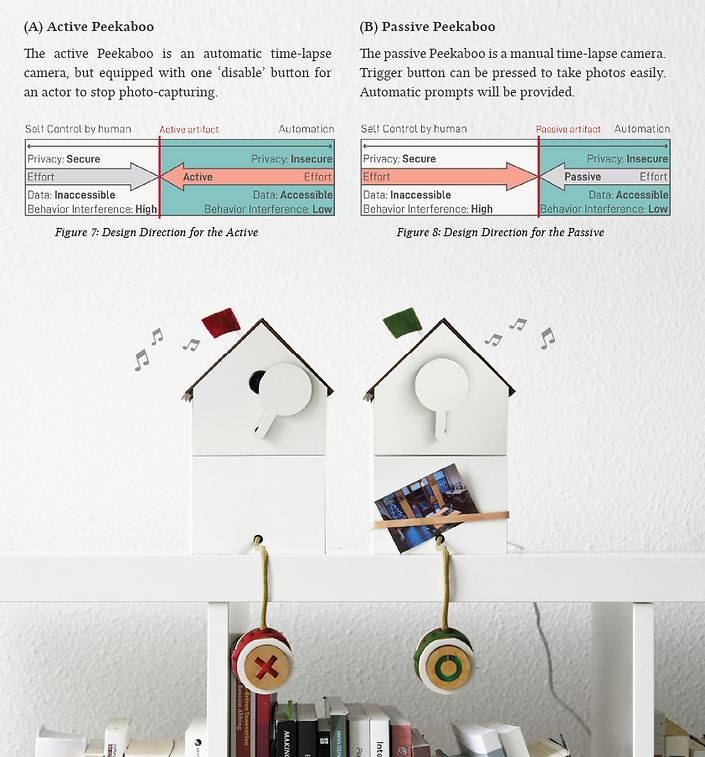Peekaboo Cam:
Designing an Observational Camera for Home Ecologies Concerning Privacy

Overview:
The home is a rich context for design research to study things and the Everyday. However, home is also a place of utmost privacy for most people. To better understand this context through an observational artifact without impacting privacy, we designed the Peekaboo cam that enables inhabitants to control their data release actively or passively. The Peekaboo cam is an observational research camera with a coverable lens. We validate in a field study in two homes for 14 days. The resulting photo streams provide qualitative insights on Everyday things in transition. We suggest four design guidelines for observational artifacts for home ecologies.
Methods:
-
Research through Design
-
Semi-Structured Interview
-
Design Intervention (Field Study)
-
Thematic Analysis
Results & Contribution:
-
An Open Source Interactive Home Research Camera
-
[to be updated]
Collaborators & Acknowledgement:
Rung-Huei Liang (supervisor), Lin-Lin Chen (supervisor), Yi-Ching (Janet) Huang (researcher), Jane Yung-Jen Hsu (researcher).
Publications:
Yu-Ting Cheng, Mathias Funk, Wenn-Chieh Tsai, and Lin-Lin Chen. 2019. Peekaboo Cam: Designing an Observational Camera for Home Ecologies Concerning Privacy. In Proceedings of the 2019 on Designing Interactive Systems Conference (DIS '19). Association for Computing Machinery, New York, NY, USA, 823–836. https://doi.org/10.1145/3322276.3323699
Brief
The following presents a brief introduction and research photos of the project. More details can be seen in my publication or contact me for further information.
MOTIVATION
“What would happen?
If every human being on earth disappeared?
This isn’t the story of how we might vanish.
It is the story of what happens to the world we leave behind.”
(Life After People, 2008)

Motivation: Studying the Ecology [5] of Daily Objects without Human Presence
As implied in the quote mentioned above, a home without human inhabitants can present an ecology, shaped only by daily objects [16, 19, 21]. The curiosity inspired by such an ecology encourages researchers to explore and study daily objects without human presence. It can represent a perspective into interactions between objects and their environment [12]. Through temporal and spatial changes in a home, various appliances and household items may shape multiple mini-habitats. Each formed habitat can indicate inhabitants’ intentions and needs (see Figure 1).
Our Scope: Designing an Observational Artifact in the Home Concerning Privacy
Studying various daily objects in transition may shed new light on home ethnography. Designing an artifact for researchers to study the ecology of daily objects in a home, involves challenges, such as intrusion into inhabitants’ privacy.
The home is a place of utmost privacy for most people. To observe such an environment, an artifact should be designed to not only fulfill the direct data requirements (capture temporal and spatial transitions without human presence), but also to respect the privacy of the home.
Privacy can be described as the sense of control that inhabitants can perceive over the flow of their personal data. An interactive design should prevent unwanted accidents and behave predictively. An interaction that can make an inhabitant feel in control of their data is significant. However, the requirement of rich research data and privacy concerns can conflict. Maximizing privacy creates limitations for studying a home. Similarly, attempts to collect more data from a home could lead to a greater sense of insecurity for inhabitants, regarding their data.
To design an observational artifact, a middle ground needs to be found. Our research questions can be presented as follows:
-
How to design an observational artifact that can not only capture rich information about the ecology of daily objects, but also protect the privacy of inhabitants?
-
What is the impact on the life of inhabitants and collected dataset?


DESIGN EXPLORATION




PEEKABOO CAM
An interactive camera that can collaborate with home residents to captures object arrangement of an in-situ home activitiy without human presence.
Based upon the previous explorations, an observational artifact was designed. Our artifact should provide a form which can capture fixed time-lapse photos, and an interaction that enables inhabitants to control data actively or passively. Therefore, a design with different modes of interaction is presented: the passive and the active.
With the use of a Raspberry Pi, we programmed every functionality via Python scripts to control 2 servo motors, a trigger button, and a speaker (see Figure 4). The Figure 5 shows our form design for privacy. Inspired by the cuckoo clock, a Peekaboo cam was designed. The Peekaboo cam with a moving shutter prevented the concerns of peeking. Additionally, the cam indicated the photo-capturing moments in time by emitting audio or mechanical signals like raising a flag.

DESIGN DETAILS
FIELD STUDY
The Peekaboo Cam was deployed in two family homes for 14 days. The interactions of the families with the Peekaboo Cam were investigated in this study. An evaluation of how the artifact discussed various identified design challenges was performed. The two families are anonymous and referred to as family A and family B. This study was conducted in the Netherlands.












